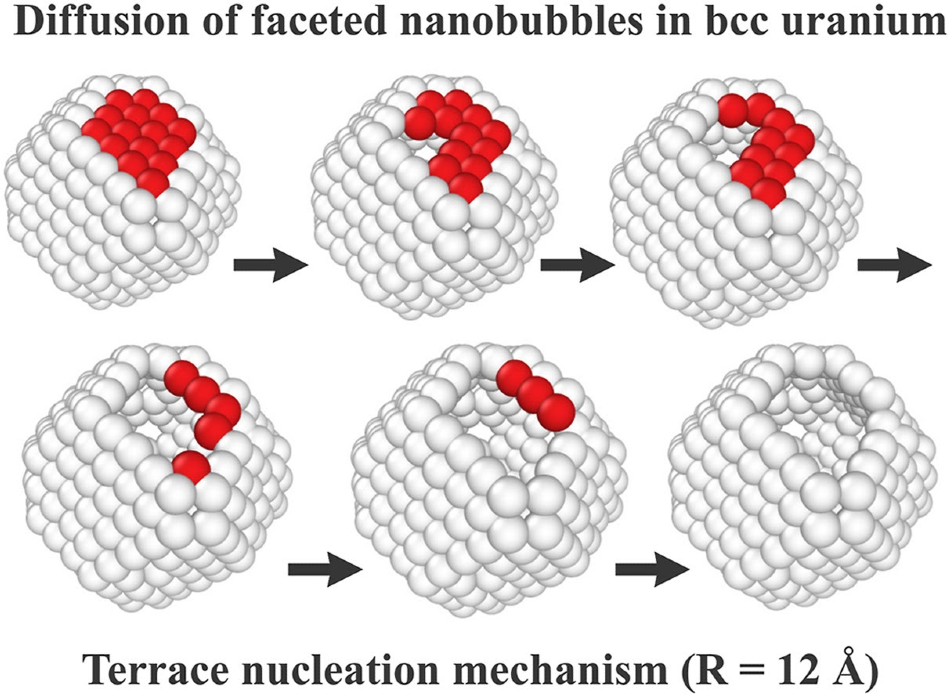Apr 21 2020
At the Moscow Institute of Physics and Technology (MIPT), scientists have devised a technique that accelerates the calculation of nanobubble diffusion in solid materials.
 Sequential face rearrangements in a nanobubble with a 12-angstrom radius. Image Credit: Alexander Antropov, Vladimir Stegailov/Journal of Nuclear Materials.
Sequential face rearrangements in a nanobubble with a 12-angstrom radius. Image Credit: Alexander Antropov, Vladimir Stegailov/Journal of Nuclear Materials.
This technique enables the development of much more precise fuel models for nuclear power plants. The study was reported in the Journal of Nuclear Materials.
Why Does Nuclear Fuel ‘Age’?
When the reactor is in operation, fission fragments that fly through the crystal lattice of the nuclear fuel material at high speeds lead to several defects, such as interstitial atoms, vacancies, and their clusters.
Together, these vacancies lead to the formation of bubbles that get filled up with fission gas products at the time of fuel burnout. When such nanobubbles diffuse, the properties of the fuel and the discharge of gaseous fission products from it are considerably affected.
Modeling to the Rescue
It is highly difficult to study fuel aging processes through experiments. Firstly, these processes are very slow, and secondly, it is virtually impossible to collect experimental data when the reactor is in operation.
At present, integrated models are being designed to enable the calculation of the evolution of the properties of fuel material when the burnout process occurs. In such models, the nanobubble diffusion coefficient is one of the main parameters. This research is a collaborative project of MIPT and the Joint Institute for High Temperatures of the Russian Academy of Sciences.
From Schrödinger Equation to Dynamics of Hundreds of Thousands of Atoms
Atomistic models of the material containing hundreds of thousands of atoms were studied by the team at the Laboratory of Supercomputer Methods in Condensed Matter Physics at MIPT. The researchers used supercomputers to calculate their trajectories over hundreds of millions or even billions of integration steps.
The physicists used the gamma uranium interatomic interaction model acquired during their earlier study, which was based on solving the quantum mechanical problem for a multielectron system.
According to Alexander Antropov, a doctoral student at MIPT and a co-author of the study, “For the nanobubble to move, it is necessary for the lattice atoms to cross over to the other side of the bubble. This is similar to an air bubble moving in water. However, in solid materials, this process is much slower.”
When working on the project, we demonstrated that there is another difference: The pores in the lattice take the form of polyhedra and the stable faces inhibit the diffusion process. In the 1970s, the possibility of such an effect was predicted theoretically based on general considerations. Our method makes it possible to obtain quantitative results for a specific material.
Alexander Antropov, Doctoral Student, MIPT
“Due to the fact that the diffusion of nanobubbles is very slow, the only real way to model their movement is to somehow give them a push. The problem, however, is how do you push a void? While working on the project, we proposed and established a method, in which an external force acts on the material surrounding the nanopore,” stated Vladimir Stegailov, professor and head of the MIPT Laboratory of Supercomputer Methods in Condensed Matter Physics.
The bubble begins to float upwards, similarly to a bubble in water under the buoyant force of Archimedes’ principle. The proposed method is based on the Einstein-Smoluchowski relation and makes diffusion coefficient calculations dozens of times faster. In the future, we plan to use it for other materials that are exposed to severe radiation damage in nuclear reactors.
Vladimir Stegailov, Professor, MIPT